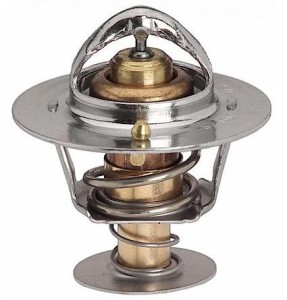Two important things about a thermostat include :
- An overheating engine may result from a faulty thermostat.
- An engine that does not get warm enough always indicates a faulty thermostat.
To replace the thermostat, coolant will have to be drained from the radiator drain petcock to lower the coolant level below the thermostat. It is not necessary to completely drain the system. The hose should be removed from the thermostat housing neck and then the housing removed to expose the thermostat.

Failure to set the thermostat into the recessed groove will cause the housing to become tilted when tightened.
The gasket flanges of the engine and thermostat housing should be cleaned, and the gasket surface of the housing must be flat. The thermostat should be placed in the engine with the sensing pellet toward the engine. Make sure that the thermostat position is correct, and install the thermostat housing with a new gasket or O-ring.
CAUTION: Failure to set the thermostat into the recessed groove will cause the housing to become tilted when tightened. If this happens and the housing bolts are tightened, the housing will usually crack, creating a leak.
The upper hose should then be installed and the system refilled. Install the correct size of radiator hose clamp.
Next Steps towards ASE Certification
Now that you’re familiar with Thermostat Replacement, try out our free Automotive Service Excellence Tests to see how much you know!
![ASE Certification Training HQ - Free ASE Practice Tests [Updated 2021]](https://asecertificationtraining.com/wp-content/themes/simplefolio/images/ASE Certification Logo.png)
